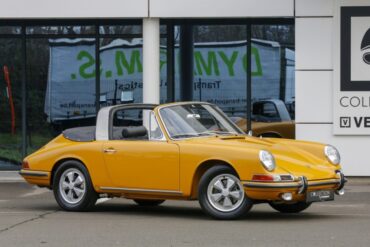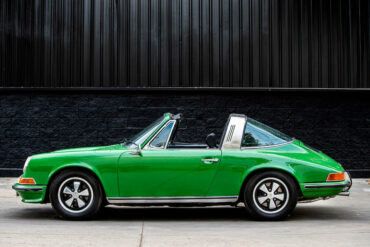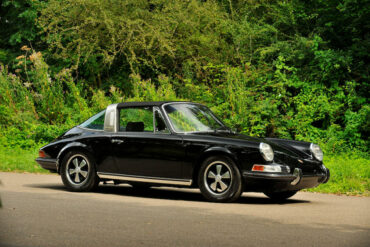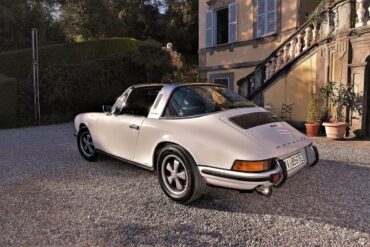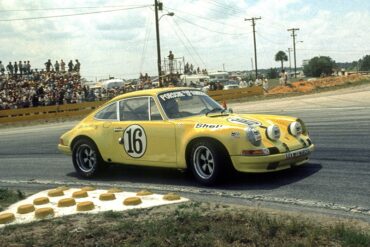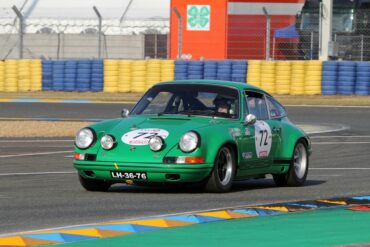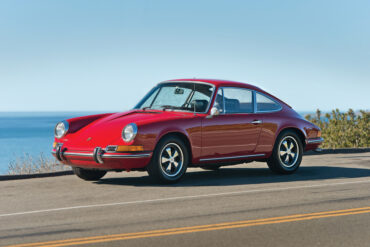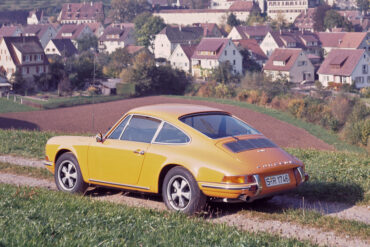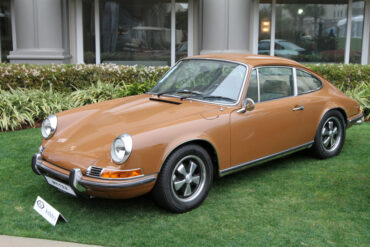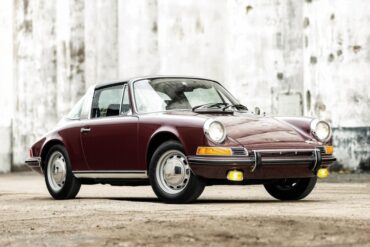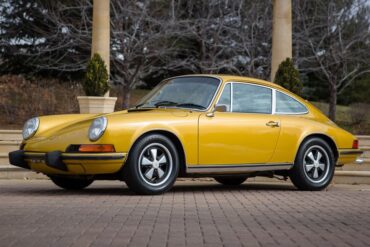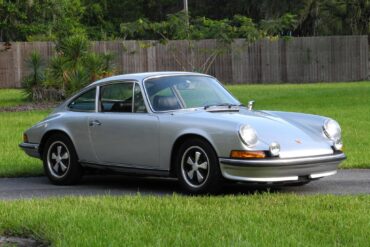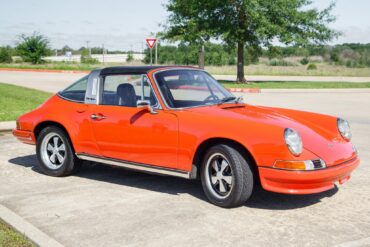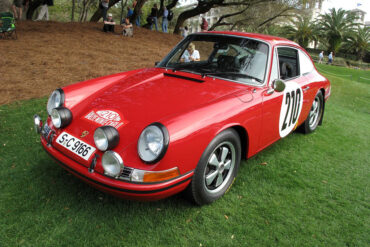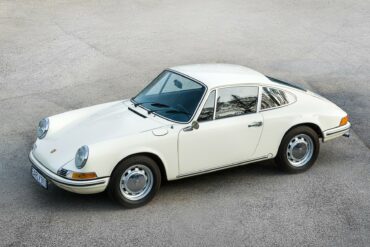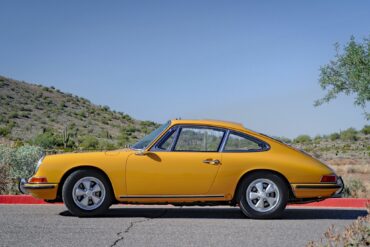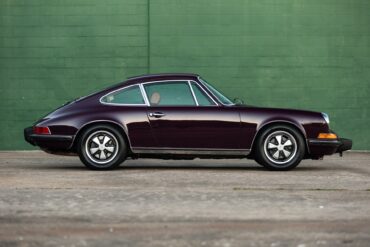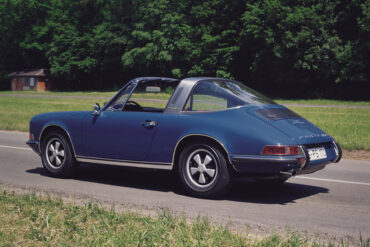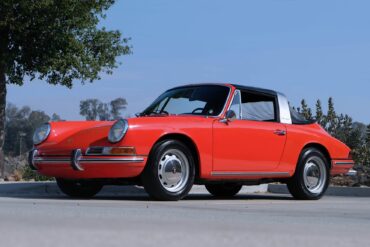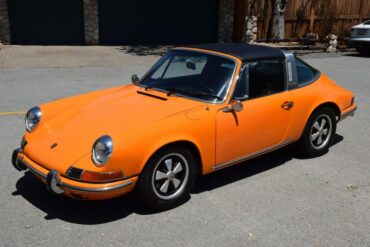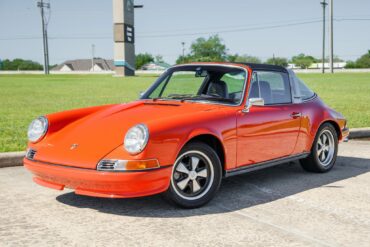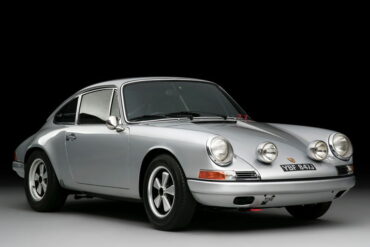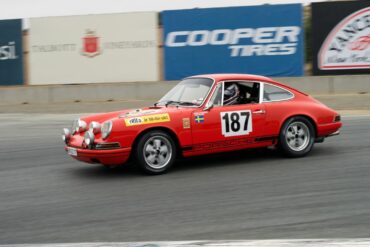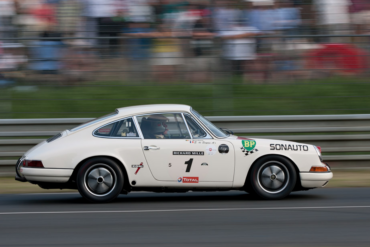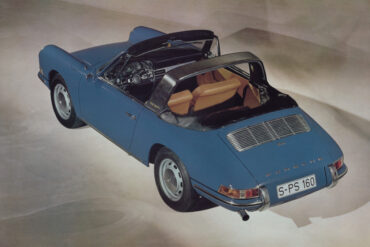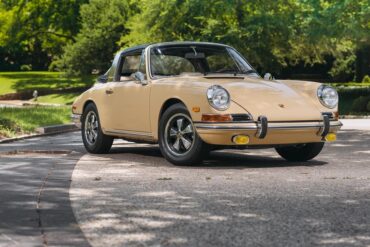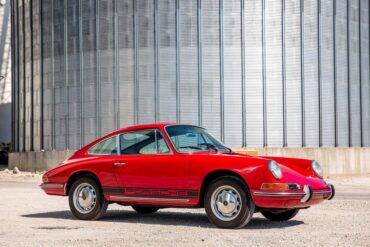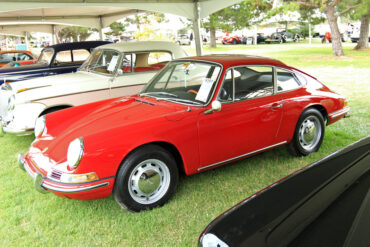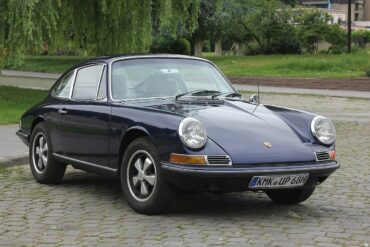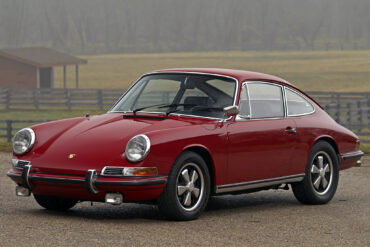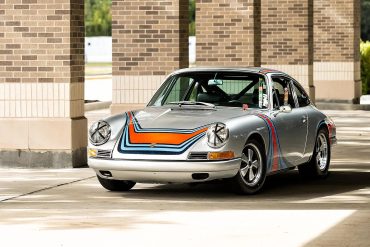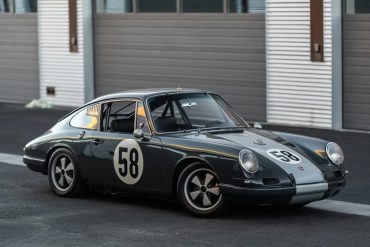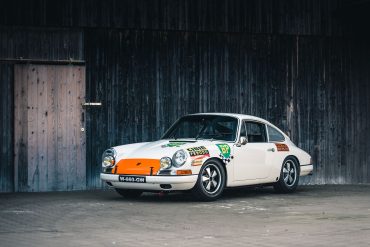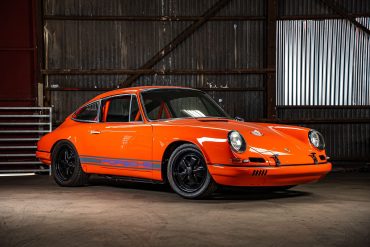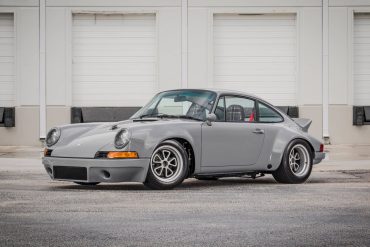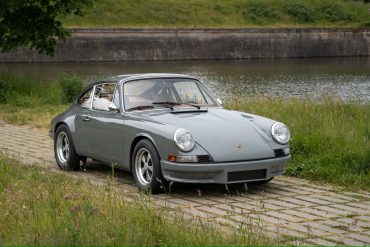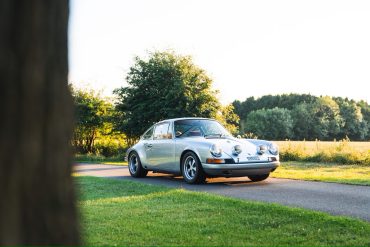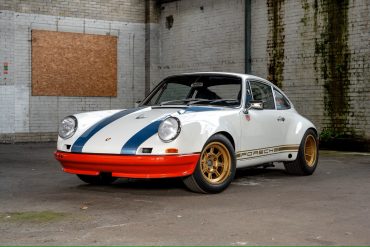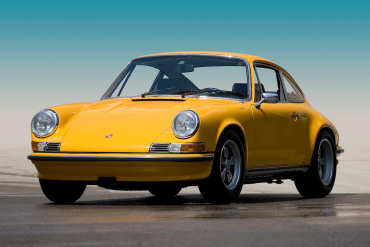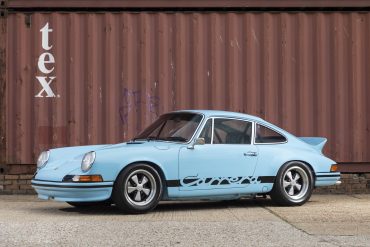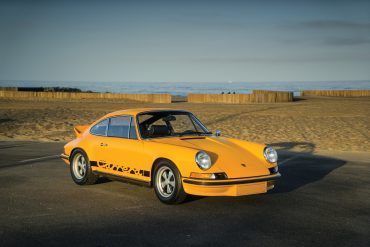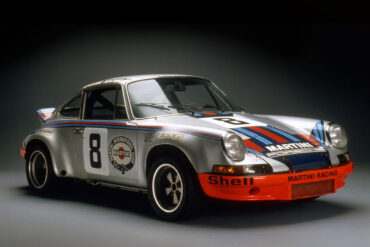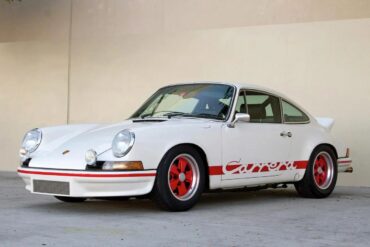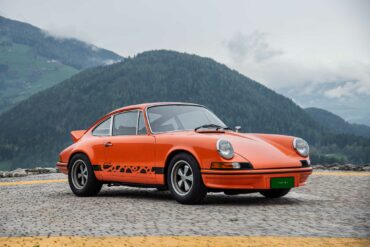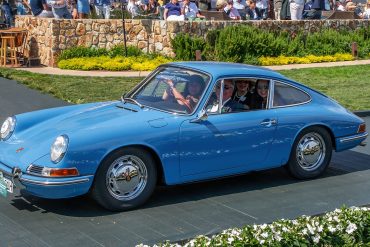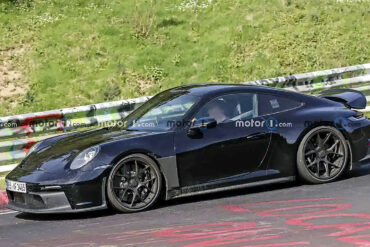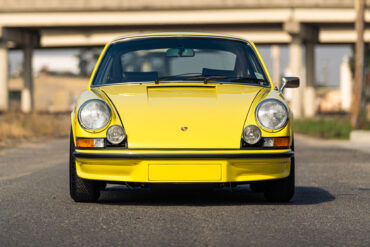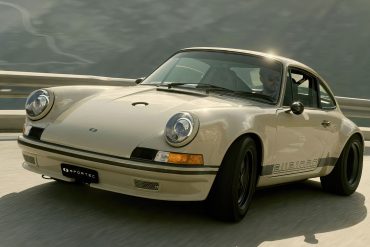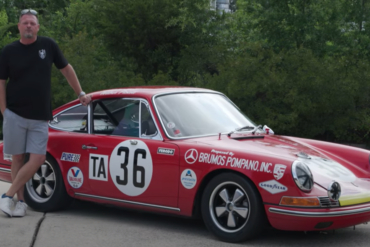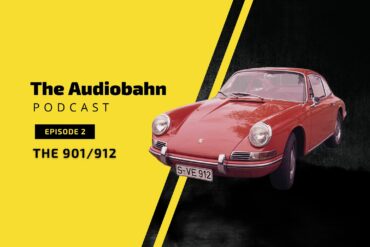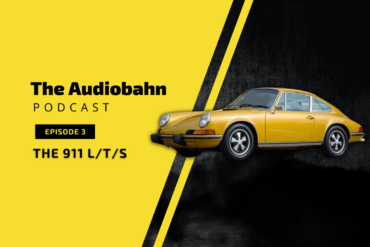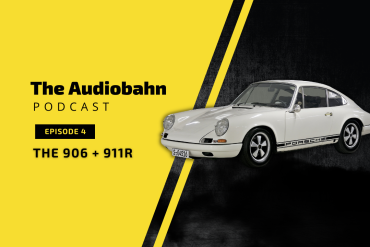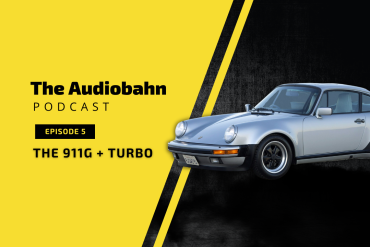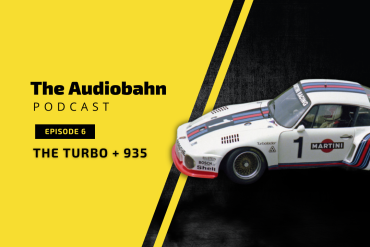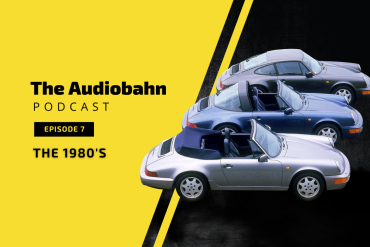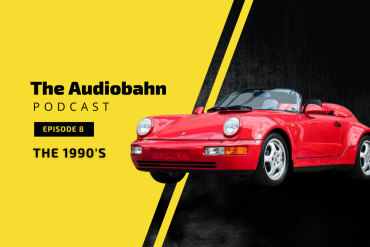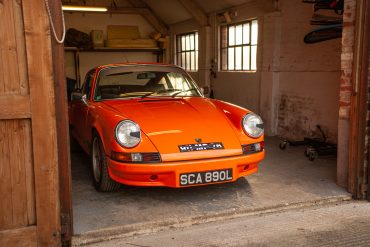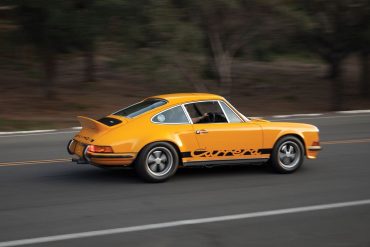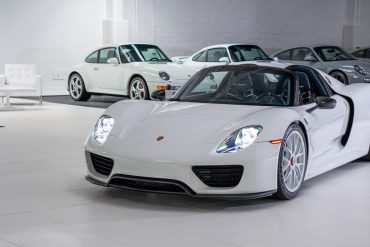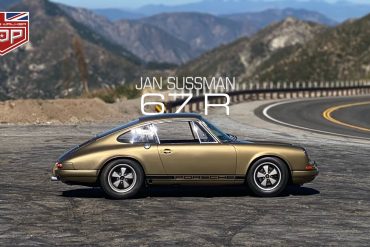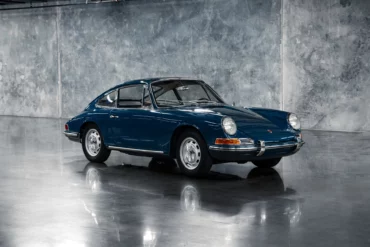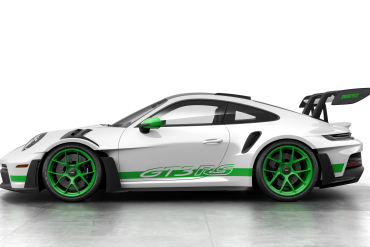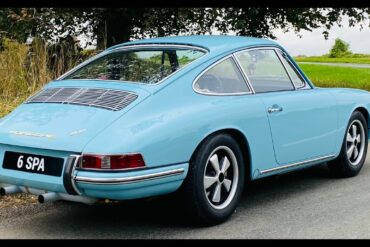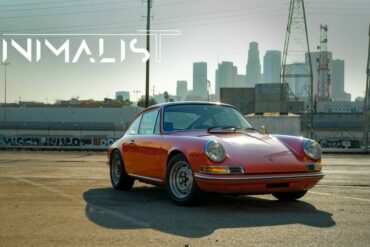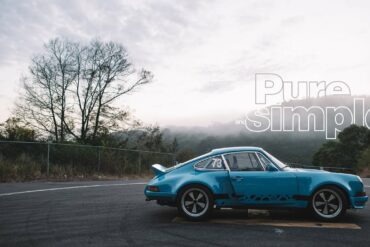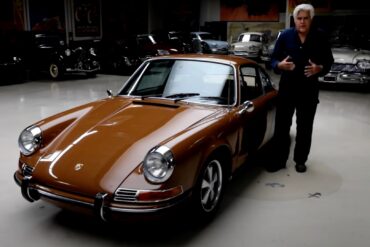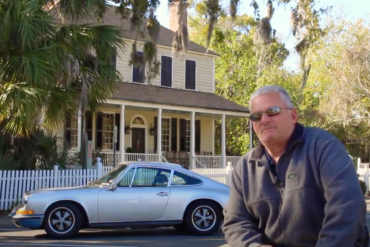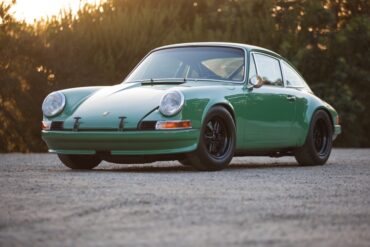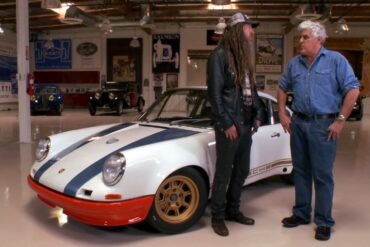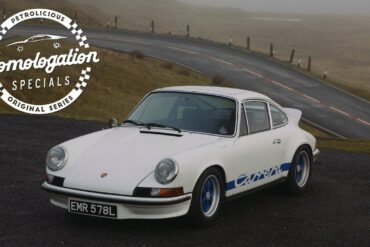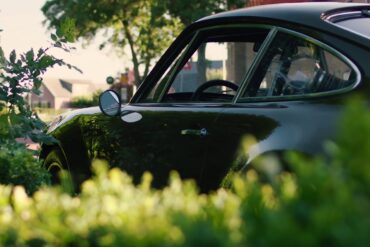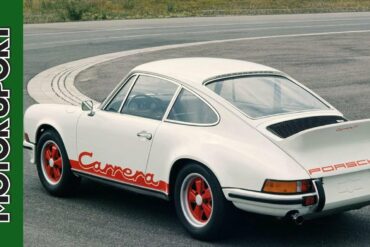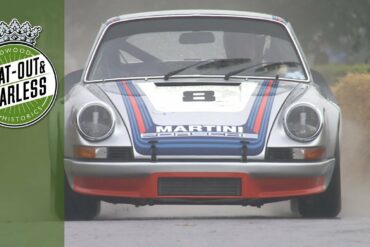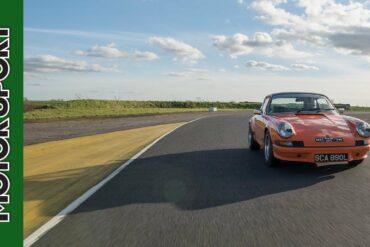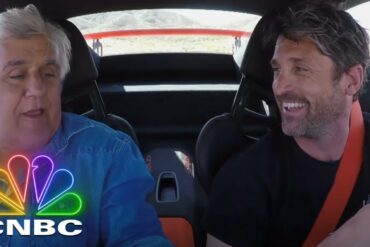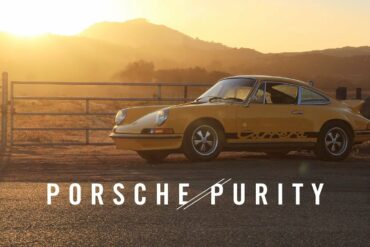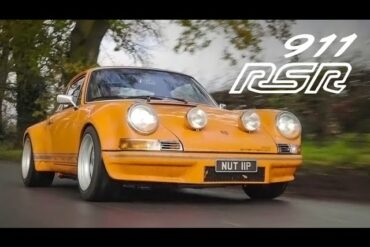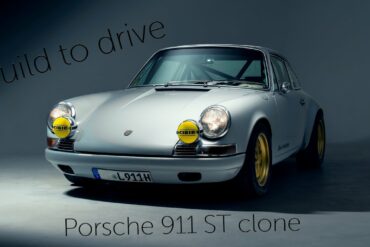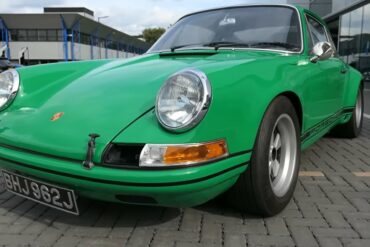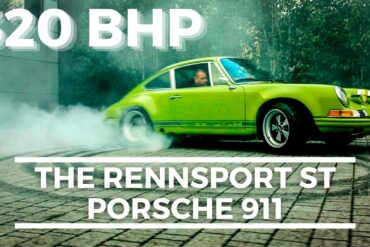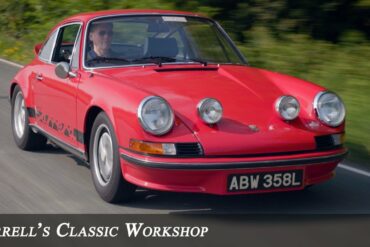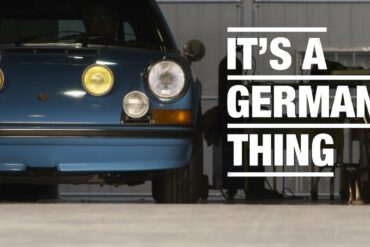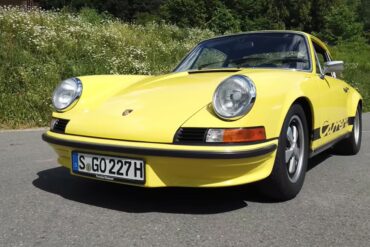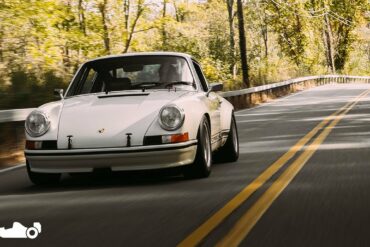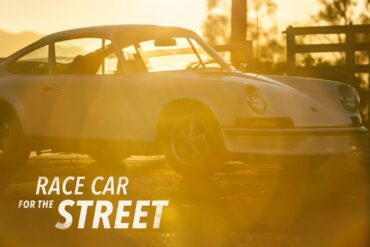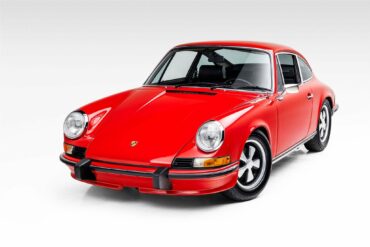1967 – 1968 Porsche 911 S Targa 2.0 (SWB) Technical Specifications Engine Type Flat 6 Induction Normally-aspirated Cooling Air/oil-cooled Valvetrain...
Porsche 911 (F-Series)
The Porsche 911 was introduced to the world in the fall of 1963 at the Frankfurt Motor Show. It was developed as a replacement for the highly successful Porsche Model 356. It was larger, more powerful, more comfortable and more competitive on the track than any other comparable car on the market at the time. The original air-cooled, boxer-engined 911 was in production from 1964 through 1989, but on this page, we are focused on the original F-Body cars. For 1969 Porsche made the single biggest change to the 911 thus far by lengthening the wheelbase 2.5 inches to reduce the oversteer characteristics inherent to rear-engined cars. Pre-1969 cars are often referred to as the short-wheel base cars (SWB) and 1969 onwards called the long-wheelbase cars (LWB). 1972 and 1973 can also be taken as one group because there were very few changes from year to year. See all of our F-Body Classic 911 Research.
1969 Porsche 911 S Targa 2.0 (LWB) Technical Specifications Induction Normally-aspirated Cooling Air/oil-cooled Valvetrain Single overhead camshaft Injection Port injection...
1970 – 1971 Porsche 911 E Targa 2.2 (LWB) Technical Specifications Induction Normally-aspirated Cooling Air/oil-cooled Valvetrain Single overhead camshaft Injection...
1972 – 1973 Porsche 911 S Targa 2.4 (LWB) Technical Specifications Induction Normally-aspirated Cooling Air/oil-cooled Valvetrain Single overhead camshaft Injection...
Porsche developed the S/T, of which 33 were built in 1970 and 1971, taking full advantage of new FIA rules allowing a two-inch wider track. Accordingly, wheel arches were widened to accommodate seven-inch front and nine-inch rear wheels. Weight reduction was even more radical, including thinner-gauge steel for the roof and floorpans. Heating ducts, seat slide supports, the glove-box lid, ashtray, sun visors and rear torsion-bar covers were deleted.
1971 Porsche 911 S/T Pictures & Gallery...
The Porsche 911L (Lux) was introduced in model year 1968 in both Europe and the United States in coupe and targa variants. Approximately 1,610 samples were produced in total, of which 1,169 were coupes, and 575 were Targas. For the 1969 model year, the 911L would cease to exist, paving the way for a new mid-tier offering in Europe and the US, the 1969 911E, and for the higher-end 1969 911S in North America.
The Porsche 911T continued as the entry level 911 for the 1970 and 1971 model years, sitting below the 2.2L 911 E and the 2.2 L 911 S. The 911 T featured all the upgrades that came with C-Series production updates including longer wheelbase and Fuchs alloy wheels. During its production years it was available as both a Coupe or Targa bodystyle. As with the E and S variants, Porsche would upgrade the 911T to a larger 2.2 liter engine.
1970 – 1971 Porsche 911 T 2.2 Coupe (LWB) Pictures & Gallery...
1970 – 1971 Porsche 911 T 2.2 Targa (LWB) Pictures & Gallery ...
The 911T Coupe and Targa continued as the entry level 911 for 1972 and 1973. As with the higher-end E and S variants, Porsche upgraded the 911T to a new, larger 2.3 L engine, commonly known as the "2.4 L" engine. With the power and torque increase, the 2.4-liter cars also got the newer and stronger transmission. Non-US versions (ROW), were carbureted and featured the Type 911/57 engine, rated at 130 hp. US-spec 911T's had engine Type 911/51 and were rated at 140 hp.
1972 – 1973.5 Porsche 911 T 2.4 Coupe (LWB) Pictures & Gallery ...
1972 – 1973 Porsche 911 T 2.4 Targa (LWB) Pictures & Gallery...
1968 – 1969 Porsche 911 T Coupe 2.0 (SWB & LWB) Pictures & Gallery...
1968 – 1969 Porsche 911 T Coupe 2.0 (SWB & LWB) Technical Specifications Engine Type Flat 6 Induction Normally-aspirated Cooling...
1970 – 1971 Porsche 911 T Coupe 2.2 (LWB) Technical Specifications Induction Normally-aspirated Cooling Air/oil-cooled Valvetrain Single overhead camshaft Injection...
1972 – 1973.5 Porsche 911 T Coupe 2.4 (LWB) Technical Specifications Induction Normally-aspirated Cooling Air/oil-cooled Valvetrain Single overhead camshaft Injection...
1968 – 1969 Porsche 911 T Targa 2.0 (SWB & LWB) Pictures & Gallery...
1968 – 1969 Porsche 911 T Targa 2.0 (SWB & LWB) Technical Specifications Engine Type Flat 6 Induction Normally-aspirated Cooling...
1970 – 1971 Porsche 911 T Targa 2.2 (LWB) Technical Specifications Induction Normally-aspirated Cooling Air/oil-cooled Valvetrain Single overhead camshaft Injection...
1972 – 1973.5 Porsche 911 T Targa 2.4 (LWB) Technical Specifications Induction Normally-aspirated Cooling Air/oil-cooled Valvetrain Single overhead camshaft Injection...
To homologate the 1968 911 for competition purposes, Porsche began with the Spartan 911 T which were a full 54 kg (118 pounds) lighter than their 'S' siblings. Porsche offered clients the opportunity to buy a 911 T outfitted with competition equipment directly from the factory, and the resulting cars have become known as the 911 T/R. They were built in low quantities to a range of specifications depending on their intended competition purposes.
1968 Porsche 911 T/R Pictures & Gallery ...
1968 Porsche 911 TR Technical Specifications Configuration Type 901/22 B6 Location Rear, longitudinally mounted Construction aluminium block and head Displacement...
1967 – 1968 Porsche 911 Targa Pictures & Gallery...
1967 – 1968 Porsche 911 Targa Technical Specifications Type Series Production Car Built At Germany Body Stylist Ferdinand Engine Flat-6...
Put most simply, a 912 is essentially a 911-style body mated with a 356-derived 4-cylinder engine. The 356 was Porsche’s first mass-marketed sports car. The Porsche 911 is the most successful sports car of all time. the new 912 came equipped with 90HP motor was a slightly detuned version of the 95HP motor that had powered its predecessor, the 356SC. However, despite this reduction of power, and despite the 912 being a heavier car, it was actually faster than the 356SC thanks to more streamlined aerodynamics and a more advanced suspension system.
1965 – 1969 Porsche 912 Pictures & Gallery...
1965 – 1969 Porsche 912 Technical Specifications Base Price in U.S. Dollars 1965: (European Delivery Only) 1966: $4,700.00 1967: $4,790.00...
The 911 S was introduced to increase the performance potential of the very successful 911. It had a more powerful...
Introduced in 1966 to enhance the performance capabilities of the already successful 911, the 911 S boasted a more powerful...
This 1967 Porsche 911S coupe was transformed into a 911R-inspired racer in 1991 by Gary and Rod Emory of Parts...
Thanks to the launch of its modern 911 R, the original Porsche 911R has been thrust firmly back into the limelight over the...
This 1968 Porsche 911L Coupe, refinished in its original Tangerine color by SOS Customz in Oceanside, CA, received numerous modifications....
This 1970 Porsche 911 is a one-of-a-kind creation commissioned by Orbit Racing for a complete RSR/outlaw-style restoration, resulting in an...
This 1971 Porsche 911 T Lightweight ‘Outlaw’ is a stunning classic sports car that has been tastefully ‘resto-modded’ with various...
This 1972 Porsche 911 ‘Special’ is a custom creation inspired by the early 1970s S/T model by Tuthill Porsche. Beneath...
The Porsche 911 ‘STR II’ is a custom creation designed by the renowned Magnus Walker. It pays tribute to the...
The 911 Carrera RS 2.7 stands as a testament to Porsche’s dual-use sports car concept. Born out of necessity for...
Of all the 1580 Carrera RS 2.7s, only 200 were made were ordered with this lightweight ‘Sports’ trim which made...
Revealed at the 1972 Paris Auto Show, the Carrera 2.7 RS was a special model used to homologate the 911 in Group...
Most Porsche fans know little about this epic wide-bodied 911 based race car. While the iconic 2.7 RS is every fan boys...
This particular 1973 Porsche 911 Carrera RS is a genuine M472 Touring model that was originally manufactured for the German...
Beautifully-Restored Carrera RS Lightweight Found on Issimi The Carrera 2.7 RS is the stuff of legends, well known as the...
Oldest in existence Alois Ruf’s cherished 1963 Porsche 901 prototype, the oldest in existence and formerly owned by Ferdinand Piëch,...
Will the lightweight terror from the 1970s inspire a new 911? Porsche rumors are almost as abundant as those surrounding...
Tradition is Born Each year during the second week in March, the Amelia Island Concours d’Elegance takes place at The...
If you’re ready to imagine the next “ultimate restomod” 911, you’ve come to the right place. Located in Switzerland just...
While chassis 301172 is a competent race car, it has been kept in exceptional physical and mechanical condition overall since...
Episode Two: The Porsche 901/912 Summary Welcome to The Audiobahn, the Stuttcars.com podcast focused on all things Porsche. In our first...
Episode Three: The Porsche 911 T, 911 L, & 911 S Summary Welcome to The Audiobahn, the Stuttcars.com podcast focused on...
Episode Four: The Porsche 906 & 911R Welcome to The Audiobahn, the Stuttcars.com podcast focused on all things Porsche. In our...
The Audiobahn E5: The Porsche 911 G Series (& the Turbo) Welcome to The Audiobahn, the Stuttcars.com podcast focused on all...
The Audiobahn E6: The Porsche 911 Turbo & The 935 Welcome to The Audiobahn, the Stuttcars.com podcast focused on all things...
The Audiobahn E7: Porsche in the 80s Welcome to The Audiobahn, the Stuttcars.com podcast focused on all things Porsche. In our...
The Audiobahn E8: Porsche in the 90’s Welcome to The Audiobahn, the Stuttcars.com podcast focused on all things Porsche. In our...
Written by: Glen Smale Images by: Virtual Motorpix/Glen Smale and Corporate Archives Porsche AG Already a Member? Sign in to...
Imagine, if you will, that you are in Paris, France, in October 1972. There is an automobile show, a fairly...
You already read about our preview of The White Collection auction here on Stuttcars. Fifty-five Porsches, mostly in white, with...
Based on the 911S, the 911 R was produced by Porsche to compete in the FIA’s GT 2.0 category. To...
The first 912s were made in the spring of 1965, alongside the last of the 356s. Originally the 912 was...
Porsche recently announced an update for the new 911 GT3 RS. As a tribute to the 911 Carrera RS 2.7,...
1965 911 SWB by Sports Purpose. Is this £350,000 Porsche the purest driving 911 of them all? This ’65 Porsche...
1969 Porsche 911 T Owner Story The 911 T was the most stripped-down model in the range, and arguably the...
The Air Cooled Classic 2.0L Flat Six You Need To Hear This 1969 911E is a great example of why...
A Unique Tribute From its humble beginnings, this 1970 911 enjoyed a varied life, most notably as a rather tasty...
On The Road You’ve followed this Porsche 911 T in the Restoration Blogs, now see and hear this modified boxer...
Interview the owner of a 1971 Porsche 911 In this video we Interview the owner of a 1971 Porsche 911...
A Beautiful Outlaw 71 Porsche 911T Hotrod in Leaf Green – 3.4L from Mirage International – 270hp – fully rebuilt...
On The Road In an automotive world in which long legacies of high-performance are continually trotted out and watered down...
Porsche Club of America recently released a video pitting a 2016 911R against a brand-new 992 GT3. The Audrain Group...
One Man’s Perfect 911 Short movie about my Porsche 1969 912 that was turned into my dream hot rod 911...
The Story Behind the 2.7 RS The 2.7 RS was the first 911 to carry the Carrera badge, this is...
On Board Hot off the heels of the unveiling of the new Porsche 911 RSR, we’re looking back with the...
On Board Dickie Meaden takes you behind the wheel of a Porsche 911 2.7 RS Touring in part one of...
Driving A Legend Patrick Dempsey and Jay Leno take a joy ride in a 1973 Porsche Carrera RS 2.7. With...
Perfectly Describing the Magic of the 911 2.7 RS Respected architect Jonathan Segal poetically describes what the 1973 Porsche 911 2.7L...
Sublime Or Sacrilege? ‘If you want to build something, build it how you want it.’...
Clean & Fast 911 ST Clone Karsten has build his Porsche the way he wanted it. Clean an fast, like...
How the RS differs from lesser 911s The 1973 Porsche Carrera RS is instantly recognizable thanks to its distinctive “Carrera”...
Though largely forgotten, Porsche will soon release a special new model: the 2023 911 ST. What is the ST and...
A Porsche 911 S/T Restomod Darryl Sleath investigates the Rennsport Porsche 911 ST – a 320 bhp Porsche 911 that’s...
The 911 Porsche feared no-one would buy! In this episode we bring you a rather special car, one of the...
Custom 1971 Porsche 911T Everybody has their “thing.” For John Willhoit, it’s certainly a German thing. For the past 37...
It was the first motorsport team-designed consumer grade car, first 911 with a staggered stance, and first factory-installed fixed wing....
A Porsche 911 S/T Restomod James talks about how his German-market Porsche 911 came to be a 911 ST recreation....
The Ultimate 911 In the early 1970s, Porsche found itself in need of a street car that would allow the...
European Collectibles is proud to present a 1973 Porsche 911E Coupe that is one of the 1,366 911E Coupes produced...
No More Content


